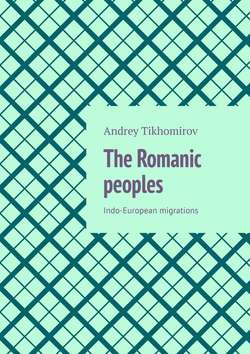Читать книгу The Romanic peoples. Indo-European migrations - Andrey Tikhomirov - Страница 3
The formation of the Romance peoples
ОглавлениеRomance peoples (novels, from the Latin name of the city of Rome – Roma) – a group of peoples of different ethnogenetic origin, united by the use of romance languages. Romance languages, a group of related languages of the Indo-European family, developed from the Latin language: Spanish (Castilian), Portuguese, Catalan, Galician, French, Occitan, Italian, Sardinian, Romansh, Romanian, Moldavian, and also extinct in the 19th century. Dalmatian language. Therefore, under the novels (Romanesque peoples) today are meant the Spaniards, Portuguese, Catalans, Galician (Gallego), French, Occitan (Provencal), Italians, Sardinians, Romansh (Ladins and Friulians), Romanians, Moldavians, etc.
Of the Romance languages that are being supplanted or supplanted by other languages, it is worth mentioning: Romansh, remnants of the Dalmatian language on the Istrian peninsula (now belongs to Italy, Slovenia and Croatia). Romance languages arose during the Romanization of the vast territories in the south, southwest and center of western Europe by the Romans from the 3rd century on. BC to 2 in. ad. The Latin language imposed by the Romans, having entered into interaction with the local languages of the indigenous inhabitants, served as a source for the formation of future Romance languages, and on their basis the Romance peoples gradually formed. Latin, as a winning language, has become the basis language for all Romance languages. However, the historical development of the emerging Romanesque peoples led to the fact that Romance languages over the centuries-old period of their development began to differ in many respects from the Latin base language.
The question of the origin of the Romance languages began to be intensively developed in the 19th and 20th centuries. In the 60s of the 19th century, the Italian linguist G. Ascoli and his followers argued that the discrepancies between the Romance languages are explained by the influence of local languages on Latin in the Romanized regions. The drawback of Ascoli’s theory, which later became known as the theory of the substrate, lies, however, in that its authors focused on the Neromanian elements in Romance languages, although the structure of these languages is clearly Roman. Local languages could influence Latin, however, the origin of all Romance languages can be correctly understood, if we proceed from the understanding of Latin as their basic language. The German philologist G. Gröber in the 80s of the 19th century emphasized that the period of Romanization lasted 300—400 years and that during this period the Latin language itself underwent certain changes. Having arrived in Dacia in the 1st century, it was already different from the Latin language, which several centuries earlier penetrated into Sardinia, and later into Iberia; and, therefore, the Romance languages formed from Latin were not only similar, but also different from each other, since each of them arose from Latin in different historical periods, and from this it is possible to determine the formation of various Romanesque peoples. Proponents of this theory, dubbed chronological, managed to show the comparatively greater linguistic archaism of Western Romance languages compared to Eastern Romance languages. For example, in Western Romance languages, in particular in French and Spanish, the plural is formed using the old Latin ending -s, while the Romanian and Italian languages no longer retain this Latin ending. However, supporters of the chronological theory did not so much explain the emergence of Romance languages as they interpreted individual cases of discrepancies observed in the sound, grammatical and lexical systems of individual languages.
At the end of the 19th century The so-called dialectic theory of the formation of Romance languages sought to substantiate the French linguist F. Moll in his book “Introduction to the Chronology of Vulgar Latin” (1899). In explaining the discrepancies between languages, he proceeded from the dialectical diversity of the Latin language itself during the period of Romanization. Depending on which local dialect of the Latin language fell into a particular Romanized province, the further destinies of the Romance languages arising in this territory were determined. This theory, however, also suffered from one-sidedness, reducing the problem of the origin of Romance languages to the dialectical discrepancies of the Latin language, which have not been studied enough. Finally, the theory of social connections determined a greater or lesser proximity between individual Romance languages and their dialects, social and economic ties that existed in antiquity between Romanized territories. Thus, the proximity of the Sicilian dialect to the Italian language and its relative remoteness from the Sardinian are explained by the primordial ties that existed between Sicily and the southern part of the Apennine peninsula. Using the data of this theory, linguists already in 1878 discovered a special Franco-Provencal group of dialects distributed in southeastern France and spreading over the territories of the regions of Savoy, Dauphine, Franche-Comté, part of Lorraine and the French part (linguistically) of Switzerland. At the same time, it was possible to establish that the well-known linguistic unity, covering so many different areas, is by no means accidental. It was on this territory that the second Burgundian kingdom existed in the 5th-6th centuries.
